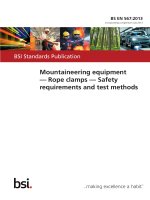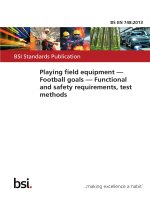Bsi bs en 61710 2013
Bạn đang xem bản rút gọn của tài liệu. Xem và tải ngay bản đầy đủ của tài liệu tại đây (1.6 MB, 60 trang )
BS EN 61710:2013
BSI Standards Publication
Power law model —
Goodness-of-fit tests and
estimation methods
BRITISH STANDARD
BS EN 61710:2013
National foreword
This British Standard is the UK implementation of EN 61710:2013. It is
identical to IEC 61710:2013. It supersedes BS IEC 61710:2000 which is
withdrawn.
The UK participation in its preparation was entrusted to Technical
Committee DS/1, Dependability.
A list of organizations represented on this committee can be obtained on
request to its secretary.
This publication does not purport to include all the necessary provisions of
a contract. Users are responsible for its correct application.
© The British Standards Institution 2013.
Published by BSI Standards Limited 2013
ISBN 978 0 580 75899 7
ICS 03.120.30; 21.020; 29.020
Compliance with a British Standard cannot confer immunity from
legal obligations.
This British Standard was published under the authority of the
Standards Policy and Strategy Committee on 30 September 2013.
Amendments/corrigenda issued since publication
Date
Text affected
BS EN 61710:2013
EUROPEAN STANDARD
EN 61710
NORME EUROPÉENNE
EUROPÄISCHE NORM
September 2013
ICS 03.120.01; 03.120.30
English version
Power law model Goodness-of-fit tests and estimation methods
(IEC 61710:2013)
Modèle de loi en puissance Essais d'adéquation et méthodes
d'estimation des paramètres
(CEI 61710:2013)
Potenzgesetz-Modell Anpassungstests und Schätzverfahren
(IEC 61710:2013)
This European Standard was approved by CENELEC on 2013-06-26. CENELEC members are bound to comply
with the CEN/CENELEC Internal Regulations which stipulate the conditions for giving this European Standard
the status of a national standard without any alteration.
Up-to-date lists and bibliographical references concerning such national standards may be obtained on
application to the CEN-CENELEC Management Centre or to any CENELEC member.
This European Standard exists in three official versions (English, French, German). A version in any other
language made by translation under the responsibility of a CENELEC member into its own language and notified
to the CEN-CENELEC Management Centre has the same status as the official versions.
CENELEC members are the national electrotechnical committees of Austria, Belgium, Bulgaria, Croatia, Cyprus,
the Czech Republic, Denmark, Estonia, Finland, Former Yugoslav Republic of Macedonia, France, Germany,
Greece, Hungary, Iceland, Ireland, Italy, Latvia, Lithuania, Luxembourg, Malta, the Netherlands, Norway, Poland,
Portugal, Romania, Slovakia, Slovenia, Spain, Sweden, Switzerland, Turkey and the United Kingdom.
CENELEC
European Committee for Electrotechnical Standardization
Comité Européen de Normalisation Electrotechnique
Europäisches Komitee für Elektrotechnische Normung
CEN-CENELEC Management Centre: Avenue Marnix 17, B - 1000 Brussels
© 2013 CENELEC -
All rights of exploitation in any form and by any means reserved worldwide for CENELEC members.
Ref. No. EN 61710:2013 E
BS EN 61710:2013
EN 61710:2013
-2-
Foreword
The text of document 56/1500/FDIS, future edition 2 of IEC 61710, prepared by IEC/TC 56
"Dependability" was submitted to the IEC-CENELEC parallel vote and approved by CENELEC as
EN 61710:2013.
The following dates are fixed:
•
latest date by which the document has to be
implemented at national level by
publication of an identical national
standard or by endorsement
(dop)
2014-03-26
•
latest date by which the national
standards conflicting with the
document have to be withdrawn
(dow)
2016-06-26
Attention is drawn to the possibility that some of the elements of this document may be the subject of
patent rights. CENELEC [and/or CEN] shall not be held responsible for identifying any or all such
patent rights.
Endorsement notice
The text of the International Standard IEC 61710:2013 was approved by CENELEC as a European
Standard without any modification.
In the official version, for Bibliography, the following notes have to be added for the standards indicated:
IEC 61703
NOTE
Harmonised as EN 61703.
IEC 61164:2004
NOTE
Harmonised as EN 61164:2004 (not modified).
BS EN 61710:2013
EN 61710:2013
-3-
Annex ZA
(normative)
Normative references to international publications
with their corresponding European publications
The following documents, in whole or in part, are normatively referenced in this document and are
indispensable for its application. For dated references, only the edition cited applies. For undated
references, the latest edition of the referenced document (including any amendments) applies.
NOTE When an international publication has been modified by common modifications, indicated by (mod), the relevant EN/HD
applies.
Publication
Year
Title
EN/HD
Year
IEC 60050-191
1990
International Electrotechnical Vocabulary
(IEV) Chapter 191: Dependability and quality of
service
-
-
–2–
BS EN 61710:2013
61710 © IEC:2013
CONTENTS
INTRODUCTION ..................................................................................................................... 7
1
Scope ............................................................................................................................... 8
2
Normative references ....................................................................................................... 8
3
Terms and definitions ....................................................................................................... 8
4
Symbols and abbreviations ............................................................................................... 8
5
Power law model .............................................................................................................. 9
6
Data requirements .......................................................................................................... 10
6.1
7
General ................................................................................................................. 10
6.1.1 Case 1 – Time data for every relevant failure for one or more copies
from the same population .......................................................................... 10
6.1.2 Case 1a) – One repairable item ................................................................. 10
6.1.3 Case 1b) – Multiple items of the same kind of repairable item
observed for the same length of time ......................................................... 11
6.1.4 Case 1c) – Multiple repairable items of the same kind observed for
different lengths of time ............................................................................. 11
6.2 Case 2 – Time data for groups of relevant failures for one or more repairable
items from the same population ............................................................................. 12
6.3 Case 3 – Time data for every relevant failure for more than one repairable
item from different populations .............................................................................. 12
Statistical estimation and test procedures ....................................................................... 13
7.1
7.2
7.3
7.4
7.5
7.6
Overview ............................................................................................................... 13
Point estimation .................................................................................................... 13
7.2.1 Case 1a) and 1b) – Time data for every relevant failure ............................. 13
7.2.2 Case 1c) – Time data for every relevant failure .......................................... 14
7.2.3 Case 2 – Time data for groups of relevant failures ..................................... 15
Goodness-of-fit tests ............................................................................................. 16
7.3.1 Case 1 – Time data for every relevant failure............................................. 16
7.3.2 Case 2 – Time data for groups of relevant failures ..................................... 17
Confidence intervals for the shape parameter ........................................................ 18
7.4.1 Case 1 – Time data for every relevant failure............................................. 18
7.4.2 Case 2 – Time data for groups of relevant failures ..................................... 19
Confidence intervals for the failure intensity .......................................................... 20
7.5.1 Case 1 – Time data for every relevant failure............................................. 20
7.5.2 Case 2 – Time data for groups of relevant failures ..................................... 20
Prediction intervals for the length of time to future failures of a single item ............ 21
7.6.1 Prediction interval for length of time to next failure for case 1 – Time
data for every relevant failure .................................................................... 21
7.6.2 Prediction interval for length of time to Rth future failure for case 1 –
Time data for every relevant failure ........................................................... 22
Test for the equality of the shape parameters β 1, β 2 , ..., β k .................................... 23
7.7.1 Case 3 – Time data for every relevant failure for two items from
different populations .................................................................................. 23
7.7.2 Case 3 – Time data for every relevant failure for three or more items
from different populations .......................................................................... 24
Annex A (informative) The power law model – Background information ................................ 30
7.7
Annex B (informative) Numerical examples .......................................................................... 31
BS EN 61710:2013
61710 © IEC:2013
–3–
Annex C (informative) Bayesian estimation for the power law model .................................... 41
Bibliography .......................................................................................................................... 56
Figure 1 – One repairable item ............................................................................................. 10
Figure 2 – Multiple items of the same kind of repairable item observed for same length
of time .................................................................................................................................. 11
Figure 3 – Multiple repairable items of the same kind observed for different lengths of
time ...................................................................................................................................... 12
Figure B.1 – Accumulated number of failures against accumulated time for software
system .................................................................................................................................. 32
Figure B.2 – Expected against observed accumulated times to failure for software
system .................................................................................................................................. 32
Figure B.3 – Accumulated number of failures against accumulated time for five copies
of a system ........................................................................................................................... 35
Figure B.4 – Accumulated number of failures against accumulated time for an OEM
product from vendors A and B ............................................................................................... 37
Figure B.5 – Accumulated number of failures against time for generators ............................. 38
Figure B.6 – Expected against observed accumulated number of failures for
generators ............................................................................................................................ 39
Figure C.1 – Plot of fitted Gamma prior (6,7956, 0,0448) ...................................................... 47
for the shape parameter of the power law model ................................................................... 47
Figure C.2 – Plot of fitted Gamma prior (17,756 6, 1447,408) for the expected number
of failures parameter of the power law model ........................................................................ 47
Figure C.3 – Subjective distribution of number of failures...................................................... 51
Figure C.4 – Plot of the posterior probability distribution for the number of future
failures, M ............................................................................................................................. 54
Figure C.5 – Plot of the posterior cumulative distribution for the number of future
failures, M ............................................................................................................................. 55
Table 1 – Critical values for Cramer-von-Mises goodness-of-fit test at 10 % level of
significance........................................................................................................................... 25
Table 2 – Fractiles of the Chi-square distribution .................................................................. 26
Table 3 – Multipliers for two-sided 90 % confidence intervals for intensity function for
time terminated data ............................................................................................................. 27
Table 4 – Multipliers for two-sided 90 % confidence intervals for intensity function for
failure terminated data .......................................................................................................... 28
Table 5 – 0,95 fractiles of the F distribution .......................................................................... 29
Table B.1 – All relevant failures and accumulated times for software system ........................ 31
Table B.2 – Calculation of expected accumulated times to failure for Figure B.2 ................... 33
Table B.3 – Accumulated times for all relevant failures for five copies of a system
(labelled A, B, C, D, E) ......................................................................................................... 34
Table B.4 – Combined accumulated times for multiple items of the same kind of a
system .................................................................................................................................. 34
Table B.5 – Accumulated operating hours to failure for OEM product from vendors A
and B .................................................................................................................................... 36
Table B.6 – Grouped failure data for generators ................................................................... 38
Table B.7 – Calculation of expected numbers of failures for Figure B.6 ................................. 40
Table C.1 – Strengths and weakness of classical and Bayesian estimation ........................... 42
–4–
BS EN 61710:2013
61710 © IEC:2013
Table C.2 – Grid for eliciting subjective distribution for shape parameter β ........................... 46
Table C.3 – Grid for eliciting subjective distribution for expected number of failures
parameter η .......................................................................................................................... 46
Table C.4 – Comparison of fitted Gamma and subjective distribution for shape
parameter β .......................................................................................................................... 48
Table C.5 – Comparison of fitted Gamma and subjective distribution for expected
number of failures by time T = 20 000 h parameter η .......................................................... 48
Table C.6 – Times to failure data collected on system test .................................................... 49
Table C.7 – Summary of estimates of power law model parameters ...................................... 50
Table C.8 – Time to failure data for operational system ........................................................ 53
BS EN 61710:2013
61710 © IEC:2013
–7–
INTRODUCTION
This International Standard describes the power law model and gives step-by-step directions
for its use. There are various models for describing the reliability of repairable items, the
power law model being one of the most widely used. This standard provides procedures to
estimate the parameters of the power law model and to test the goodness-of-fit of the power
law model to data, to provide confidence intervals for the failure intensity and prediction
intervals for the length of time to future failures. An input is required consisting of a data set
of times at which relevant failures occurred, or were observed, for a repairable item or a set of
copies of the same item, and the time at which observation of the item was terminated, if
different from the time of final failure. All output results correspond to the item type under
consideration.
Some of the procedures can require computer programs, but these are not unduly complex.
This standard presents algorithms from which computer programs should be easy to
construct.
BS EN 61710:2013
61710 © IEC:2013
–8–
POWER LAW MODEL –
GOODNESS-OF-FIT TESTS
AND ESTIMATION METHODS
1
Scope
This International Standard specifies procedures to estimate the parameters of the power law
model, to provide confidence intervals for the failure intensity, to provide prediction intervals
for the times to future failures, and to test the goodness-of-fit of the power law model to data
from repairable items. It is assumed that the time to failure data have been collected from an
item, or some identical items operating under the same conditions (e.g. environment and
load).
2
Normative references
The following documents, in whole or in part, are normatively referenced in this document and
are indispensable for its application. For dated references, only the edition cited applies. For
undated references, the latest edition of the referenced document (including any
amendments) applies.
IEC 60050-191:1990, International
Dependability and quality of service
3
Electrotechnical
Vocabulary
(IEV)
–
Chapter 191:
Terms and definitions
For the purposes of this document, the terms and definitions of IEC 60050-191 apply.
4
Symbols and abbreviations
The following symbols and abbreviations apply:
β
shape parameter of the power law model
βˆ
estimated shape parameter of the power law model
β LB , βUB
lower, upper confidence limits for β
C2
Cramer-von-Mises goodness-of-fit test statistic
C12−γ (M )
critical value for the Cramer-von-Mises goodness-of-fit test statistic at γ level of
significance
χ2
Chi-square goodness-of-fit test statistic
χ γ2 (υ )
γ th fractile of the χ 2 distribution with υ degrees of freedom
d
number of intervals for groups of failures
E [N (t )]
expected accumulated number of failures up to time t
E tj
expected accumulated time to jth failure
[ ]
BS EN 61710:2013
61710 © IEC:2013
Eˆ [N [t (i )]]
[ ]
–9–
estimated expected accumulated number of failures up to t (i )
Eˆ t j
estimated expected accumulated time to jth failure
Fγ (ν 1,ν 2 )
γ th fractile for the F distribution with (ν 1,ν 2 ) degrees of freedom
i
general purpose indicator
j
general purpose indicator
k
number of items
L, U
multipliers used in calculation of confidence intervals for failure intensity
λ
scale parameter of the power law model
λ
estimated scale parameter of the power law model
M
parameter for Cramer-von-Mises statistical test
N
number of relevant failures
Nj
number of failures for jth item
N (t )
accumulated number of failures up to time t
N [t (i )]
accumulated number of failures up to time t (i )
R
difference between the order number of future (predicted) failure and order
number of last (observed) failure
T
accumulated relevant time
T*
total accumulated relevant time for time terminated test
Tj
total accumulated relevant time for jth item
T RL , T RU
lower, upper prediction limits for the length of time to the Rth future failure
TN +1
estimated median time to (N + 1)th failure
ti
accumulated relevant time to the ith failure
ti j
ith failure time for jth item
tN
total accumulated relevant time for failure terminated test
tN j
total accumulated relevant time to Nth failure of jth item
t (i − 1), t (i )
endpoints of ith interval of time for grouped failures
z (t )
failure intensity at time t
zˆ(t )
estimated failure intensity at time t
z LB , zUB
lower, upper confidence limits for failure intensity
5
Power law model
The statistical procedures for the power law model use the relevant failure and time data from
the test or field studies. The basic equations for the power law model are given in this clause.
Background information on the model is given in Annex A and examples of its application are
given in Annex B.
The expected accumulated number of failures up to test time t is given by:
E [N (t )] = λt β with λ > 0, β > 0, t > 0
BS EN 61710:2013
61710 © IEC:2013
– 10 –
where
λ is the scale parameter;
β is the shape parameter ( 0 < β < 1 corresponds to a decreasing failure intensity; β = 1
corresponds to a constant failure intensity; β > 1 corresponds to an increasing failure
intensity).
The failure intensity at time t is given by:
z (t ) =
d
E [N (t )] = λβ t β −1 with t > 0
dt
Thus the parameters λ and β both affect the failure intensity in a given time.
Methods are given in 7.2 for maximum likelihood estimation of the parameters of λ and β .
Subclause 7.3 gives goodness-of-fit tests for the model and 7.4 and 7.5 give confidence
interval procedures. Subclause 7.6 gives prediction interval procedures and 7.7 gives tests for
the equality of the shape parameters. The model is simple to evaluate. However when β < 1 ,
theoretically z (0 ) = ∞ (i.e. z(t ) tends to infinity as
t tends to zero) and z(∞) = 0 (i.e. z(t ) tends
to zero as t tends to infinity); but this theoretical limitation does not generally affect its
practical use.
6
Data requirements
6.1
General
6.1.1
Case 1 – Time data for every relevant failure for one or more copies
from the same population
The normal evaluation methods assume the observed times to be exact times of failure of a
single repairable item or a set of copies of the same repairable item. The figures below
illustrate how the failure times are calculated for three general cases.
6.1.2
Case 1a) – One repairable item
For one repairable item observed from time 0 to time T, the relevant failure time, ti , is the
elapsed operating time (that is, excluding repair and other down times) until the occurrence of
the i-th failure as shown in Figure 1.
A
B
0
1
2
3
IEC 996/13
Key
A
T
operating time, B
down time
Figure 1 – One repairable item
Time terminated data are observed to T * , which is not a failure time, and failure terminated
data are observed to t N , which is the time of the Nth failure. Time terminated and failure
terminated data use slightly different formulae.
BS EN 61710:2013
61710 © IEC:2013
6.1.3
– 11 –
Case 1b) – Multiple items of the same kind of repairable item observed for the
same length of time
It is assumed there are k items, which all represent the same population. That is, they are
nominally identical items operating under the same conditions (e.g. environment and load).
When all items are observed to time T * , which is not a failure time (i.e. time terminated data),
then the failure time data are combined by superimposing failure times (t i, i = 1, 2..., N) for all k
items on the same time line as shown in Figure 2.
A
B
C
D
0
t1
t2
t3
tN-1 tN
T*
IEC 997/13
Key
A
item 1
B
item 2
C
item k
D
superimposed process
Figure 2 – Multiple items of the same kind of repairable item
observed for same length of time
6.1.4
Case 1c) – Multiple repairable items of the same kind observed for different
lengths of time
When all items do not operate for the same period of time, then the time at which observation
of the jth item is terminated T j ( j = 1, 2,..., k) , where T1 < T2 < ... < Tk , is noted. The failure data
are combined by superimposing all the failure times for all k items on the same time line as
shown in Figure 3. The times to failure are t i, i = 1, 2,..., N , where N = the total number of
failures observed accumulated over the k items.
BS EN 61710:2013
61710 © IEC:2013
– 12 –
T1
A
T2
B
T3
C
Tk
D
0
t1
t2
t3
t4
t5
t6
t
IEC 998/13
Key
A
item 1
B
item 2
C
item 3
D
item k
t
time
Figure 3 – Multiple repairable items of the same kind observed
for different lengths of time
If each item is a software system then the repair action should be done to the other systems
which did not fail at that time.
6.2
Case 2 – Time data for groups of relevant failures for one or more repairable
items from the same population
This alternative method is used when there is at least one copy of an item and the data
consist of known time intervals, each containing a known number of failures.
The observation period is over the interval (0, T ) and is partitioned into d intervals at times
0 < t(1) < t(2) < ... < t(d ) . The ith interval is the time period between t(i − 1) and t(i ) , where
=
i 1,=
2,..., d , t ( 0 ) 0 and t ( d ) = T . It is important to note that the interval lengths and the
number of failures per interval need not be the same.
6.3
Case 3 – Time data for every relevant failure for more than one repairable item
from different populations
It is assumed there are k items which do not represent the same population and are to be
compared. It should be noted that if each item is to be considered individually then it is
appropriate to use case 1a) in 6.1.2.
If direct comparisons of the items are to be made then as an extension of 6.1 the following
notation is used:
tij
denotes the ith failure time for the process corresponding to the jth item;
Nj
denotes the number of failures observed for the jth item;
tN j
is the time of the Nth failure for the jth item;
where i = 0, 1, 2, … N j and j = 1, 2, … k .
BS EN 61710:2013
61710 © IEC:2013
7
– 13 –
Statistical estimation and test procedures
7.1
Overview
In case 1 – time data for every relevant failure – the formulae given for failure terminated data
assume one repairable item, that is k = 1 . All output results correspond to that item. The
formulae given for time terminated data assume k copies of the item observed for the same
length of time. If there is only one repairable item then k = 1 . The point estimation procedures
for all the aforementioned cases are given in 7.2.1. The appropriate procedures for the case
when all copies are observed for different lengths of time are given in 7.2.2. Procedures for
the case of time data for groups of relevant failures are given in 7.2.3.
An appropriate goodness-of-fit test, as described in 7.3 shall be performed after the
parameter estimation procedures of 7.2. Note that these tests, and the procedures given in
7.4 to 7.7 for constructing interval estimates and carrying out statistical tests, distinguish only
between the cases of time data for every relevant failure (i.e. all instances of case 1 data –
1a), 1b) and 1c)) and time data for groups of relevant failures (i.e. case 2)).
The inference procedures that follow provide approximate estimates in some circumstances
and so caution is required if they are to be applied if the number of observed failures is less
than 10.
7.2
7.2.1
Point estimation
Case 1a) and 1b) – Time data for every relevant failure
This method applies only when the time of failure has been logged for every failure as
described in 6.1.2 and 6.1.3.
Step 1: Calculate the summation:
N
T*
S1 =
∑ ln t j
S2 =
∑ ln tNj
j =1
N
t
j =1
(time terminated)
(failure terminated)
Step 2: Calculate the (unbiased) estimate of the shape parameter β from the formula:
∧
N −1
S1
(time terminated)
∧
N −2
S2
(failure terminated)
β=
β=
Step 3: Calculate the estimate of the scale parameter λ from the formula:
∧
λ=
N
∧
( )
kT
* β
(time terminated)
BS EN 61710:2013
61710 © IEC:2013
– 14 –
N
∧
λ=
k (tN )
∧
β
(failure terminated)
Step 4: Calculate the estimate of the failure intensity z(t), for any time t > 0 , from the formula:
∧
∧∧ ∧
z (t ) = λ β t β − 1
∧
z (t ) estimates the current failure intensity for t over the range represented by the data.
"Extrapolated" estimates for a future t may be obtained similarly, but should be used with the
usual caution associated with extrapolation.
Step 5: Given N observed failures the last of which occurred at t N
, the median time to the
(N + 1 ) th failure can be estimated from the formula:
7.2.2
TˆN + 1
−1
0,5 N + 1 − 1
= t N exp
ˆ
Nβ
(N − 1)
(time terminated)
TˆN + 1
−1
0,5 N + 1 − 1
= t N exp
ˆ
Nβ
(N − 2)
(failure terminated)
Case 1c) – Time data for every relevant failure
This method applies only when the time of failure has been logged for every failure as
described in 6.1.4.
Step 1: Assemble the data into the times to failure, ti , i= 1,2,..,N, where N is the total number
of failures over the k copies and T j , j=1,2,...,k, is the end of the observation period for the jth
copy.
Step 2: The maximum likelihood estimate of the shape parameter β is the value of βˆ which
satisfies the formula:
N
+
βˆ
N
∑ ln ti −
i =1
N
k
ˆ
∑ T jβ ln T j
j =1
k
βˆ
∑Tj
=0
j =1
An iterative method shall be used to solve the formula for βˆ .
Step 3: Calculate the estimate of the scale parameter λ from the formula:
BS EN 61710:2013
61710 © IEC:2013
– 15 –
λˆ =
N
k
ˆ
∑ T jβ
j =1
Step 4: Calculate the estimate of the failure intensity z(t), for any time t > 0 , from the formula:
∧ ∧ ∧
∧
z(t ) = λ β t β −1
∧
z(t ) estimates the current failure intensity for t over the range represented by the data.
"Extrapolated" estimates for a future t may be obtained similarly, but should be used with the
usual caution associated with extrapolation.
7.2.3
Case 2 – Time data for groups of relevant failures
This method applies when the data set consists of known time intervals, each containing a
known number of failures as described in 6.2.
Step 1: Assemble into a data set the number of relevant failures N i recorded in the ith
interval [t (i − 1), t (i )], i = 1, 2,..., d . The total number of relevant failures is
N=
d
∑ Ni
i =1
Step 2: The maximum likelihood estimate of the shape parameter β is the value of βˆ which
satisfies the formula:
∧
∧
[t (i )]β ln t (i ) − [t (i − 1)]β ln t (i − 1)
Ni
− ln t (d ) = 0
∧
∧
i =1
[t (i )]β − [t (i − 1)]β
d
∑
∧
∧
Note that [t(0)]β = 0 and [t (0 )]β ln t(0) = 0 . All t(.) terms may be normalized with respect to t (d )
and then the final term
ln t ( d ) disappears. An iterative method shall be used to solve the
formula for βˆ .
Step 3: Calculate the estimate of the scale parameter λ from the formula:
∧
λ=
N
∧
t (d )β
Step 4: Calculate the estimate of the failure intensity z(t), for any test time t > 0 , from the
formula:
∧
∧∧ ∧
z (t ) = λ β t β − 1
BS EN 61710:2013
61710 © IEC:2013
– 16 –
∧
z(t ) estimates the current failure intensity for t over the range represented by the data.
"Extrapolated" estimates for a future t may be obtained similarly, but should be used with the
usual caution associated with extrapolation.
7.3
Goodness-of-fit tests
7.3.1
Case 1 – Time data for every relevant failure
7.3.1.1
Cramer-von-Mises test
Step 1: Calculate βˆ from step 2 in 7.2.1 or step 2 in 7.2.2.
Step 2: Calculate the Cramer-von-Mises goodness-of-fit test statistic given by the formula:
t j
1
C2 =
+
T
12M
j = 1
M
∑
∧
β
2 j − 1
−
2 M
2
where
M = N and T = T *
(time terminated)
M = N − 1 and T = t N
(failure terminated)
Step 3: Select the critical value C 02,90 (M ) for the Cramer-von-Mises test corresponding to M
from Table 1, which gives critical values at a 10 % significance level.
Step 4: If:
C 2 > C 02,90 ( M )
then the hypothesis that the power law model fits the data cannot be accepted. Otherwise, on
the basis of the data analysed, the power law model can be used as a working hypothesis.
7.3.1.2
Graphical procedure
When the failure times are known, the graphical procedure described below may be used to
obtain additional information about the correspondence between the model and the data. This
involves plotting the expected time to the jth failure, E ( t j ) , against the observed time to the
jth failure. Further details about the approach are given in Annexes A and B.
Step 1: Calculate βˆ from step 2 in 7.2.1 and λˆ from step 3 in 7.2.1.
Step 2: Calculate the estimate of the expected time to the jth failure, j=1,2,..,N, from the
formula:
∧
1
j∧
E (t j ) = β
λˆ
BS EN 61710:2013
61710 © IEC:2013
– 17 –
∧
Step 3: Plot E (t j ) against t j on identical linear scales. The visual agreement of these points
with a line of 45 ° through the origin is a subjective measure of the applicability of the model.
7.3.2
7.3.2.1
Case 2 – Time data for groups of relevant failures
Chi-square test
Step 1: Calculate βˆ from step 2 in 7.2.3 and
λ
from step 3 in 7.2.3.
Step 2: Calculate the expected number of failures in the time interval [t (i − 1), t (i )] which is
approximated by:
ˆ
ˆ
ei = λˆ [t(i )]β − [t(i − 1)]β
Step 3: For each interval, e i shall not be less than 5, and if necessary, adjacent intervals
should be combined before the test. For d intervals (after combination if necessary) and with
N i the same as in 7.2.3, calculate the statistic:
χ2 =
d
( N i − ei ) 2
ei
i =1
∑
Step 4: Select the critical value from a χ 2 distribution with (d − 2) degrees of freedom and a
10 % significance level from Table 2, i.e. χ 02,90 (d − 2) .
Step 5: If the test statistic χ 2 exceeds the critical value χ 02,90 (d − 2) then the hypothesis that
the power law model fits the data cannot be accepted. Otherwise, on the basis of the data
analysed, the power law model can be used as a working hypothesis.
The Chi-square test is a large sample test and so will need large data sets to detect
deviations from the power law model that are practically important.
7.3.2.2
Graphical procedure
When the data set consists of known time intervals, each containing a known number of
failures, the graphical procedure described below may be used to obtain additional
information about the correspondence between the model and the data. This involves plotting
the expected number of failures against those observed at each endpoint. Further details of
the approach are given in B.5.
Step 1: For each endpoint t(i), calculate the observed number of failures from 0 to t(i) from
the formula:
N [t(i )] =
i
∑N j
j =1
Step 2: Calculate the estimate of the corresponding expected number of failures E [N [t(i )]]
from the formula:
BS EN 61710:2013
61710 © IEC:2013
– 18 –
ˆ
Eˆ [N [t(i )]] = λˆt (i )β
Step 3: Plot Eˆ [N [t (i )]] against N [t(i )] on identical linear scales. The visual agreement of these
points with a line of 45 ° through the origin is a subjective measure of the applicability of the
model.
7.4
7.4.1
Confidence intervals for the shape parameter
Case 1 – Time data for every relevant failure
The shape parameter β in the power law model determines if the failure intensity changes
with time. If 0 < β < 1 , there is decreasing failure intensity; if β = 1 , there is a constant failure
intensity; if β > 1, there is an increasing failure intensity.
For a two-sided confidence interval for β when individual failure times are available, follow
the steps below as appropriate for time and failure terminated data.
Two-sided 90 % confidence interval for β – Time terminated data
Step 1: Calculate βˆ from step 2 in 7.2.1 or from step 2 in 7.2.2.
Step 2: Calculate:
χ 02,05 (2 N )
DL =
2( N − 1)
DU =
χ 02,95 (2 N )
2( N − 1)
where the fractiles of the χ 2 distribution are given in Table 2.
Step 3: Calculate the lower confidence limit for β from the formula:
∧
β LB = D L β
and the upper confidence limit for β from the formula:
∧
β UB = DU β
Step 4: The two-sided 90 % confidence interval for β is given by (β LB , βUB ) .
NOTE
One-sided 95 % lower and upper limits for
β
are
β LB and β UB , respectively.
Two-sided 90 % confidence interval for β – Failure terminated data
Step 1: Calculate βˆ from step 2 in 7.2.1.
BS EN 61710:2013
61710 © IEC:2013
– 19 –
Step 2: Calculate:
DL =
DU =
χ 02,05 (2( N − 1))
2( N − 2)
χ 02,95 (2( N − 1))
2( N − 2)
where the fractiles of the χ 2 distribution are given in Table 2.
Step 3: Calculate the lower confidence limit for β from the formula:
∧
β LB = D L β
and the upper confidence limit for β from the formula:
∧
β UB = DU β
Step 4: The two-sided 90 % confidence interval for β is given by (β LB , β UB ) .
NOTE
7.4.2
One-sided 95 % lower and upper limits for
β
are
β LB
and
β UB , respectively.
Case 2 – Time data for groups of relevant failures
Step 1: Calculate βˆ from step 2 in 7.2.3.
Step 2: Calculate:
P(i ) =
t (i )
t (d )
with
i = 1, 2,..., d
Step 3: Calculate the expression:
∧
∧
∧
∧
[P (i )]β ln[P (i )]β − [P (i − 1)]β ln[P (i − 1)]β
d
A=
∧
∧
i =1
[P (i )]β − [P (i − 1)]β
2
∑
Step 4: Calculate:
C=
1
A
Step 5: For an approximate two-sided 90 % confidence interval for β , calculate:
BS EN 61710:2013
61710 © IEC:2013
– 20 –
S=
1,64C
N
where N is the total number of failures.
Step 6: Calculate the lower confidence limit for β from the formula:
∧
β LB = β (1 − S )
and the upper confidence limit for β from the formula:
∧
βUB = β (1 + S )
Step 7: The two-sided 90 % confidence interval for β is given by (β LB , βUB ) .
β
One-sided 95 % lower and upper limits for
7.5
Confidence intervals for the failure intensity
7.5.1
are
β LB and β UB , respectively.
NOTE
Case 1 – Time data for every relevant failure
∧
Step 1: Calculate z (t ) from step 4 in 7.2.1 or step 4 in 7.2.2.
Step 2: For a two-sided 90 % confidence interval refer to Table 3 (time terminated) and
Table 4 (failure terminated) and locate values of L and U for the appropriate sample size N.
Step 3: Calculate the lower confidence limit for z (t ) from the formula:
∧
z LB =
z (t )
U
and the upper confidence limit for z (t ) from the formula:
∧
zUB =
z (t )
L
Step 4: The two-sided 90 % confidence interval for z (t ) is given by (z LB , zUB ).
NOTE
7.5.2
One-sided 95 % lower and upper limits for
z (t ) are z LB and zUB , respectively.
Case 2 – Time data for groups of relevant failures
Step 1: Calculate
∧
z(t ) from step 4 in 7.2.3.
Step 2: Calculate:
P(i ) =
t (i )
t (d )
with
i = 1, 2,..., d
BS EN 61710:2013
61710 © IEC:2013
– 21 –
Step 3: Calculate:
∧
∧
∧
∧
[P (i )]β ln[P (i )]β − [P (i − 1)]β ln[P (i − 1)]β
d
A=
∧
∧
i =1
[P (i )]β − [P (i − 1)]β
2
∑
Step 4: Calculate:
1
+1
A
D=
Step 5: For an approximate two-sided 90 % confidence interval for z (t ) calculate:
S=
1,64 D
N
where N is the cumulative number of relevant failures.
Step 6: The lower confidence limit on z (t ) is given by:
z LB =
zˆ(t )
1+ S
and the upper confidence limit on z (t ) is given by:
zUB =
zˆ(t )
1− S
Step 7: The two-sided 90 % confidence interval for z (t ) is given by (z LB , zUB ).
z (t ) are z LB and zUB , respectively.
NOTE
One-sided 95 % lower and upper limits for
7.6
Prediction intervals for the length of time to future failures of a single item
7.6.1
Prediction interval for length of time to next failure for case 1 –
Time data for every relevant failure
For a two-sided 90 % prediction interval for the time to the (N + 1)th failure T N+1 , that is, the
next future failure given that N failures have occurred at times t1,t 2 ,..., t N , follow the steps
below as appropriate for time and failure terminated data.
Step 1: Calculate βˆ from step 2 in 7.2.1 or from step 2 in 7.2.2.
Step 2: Calculate the lower prediction limit for T N+1 from the formula:
– 22 –
T1L = t N
−1
0,95 N −1 − 1
exp
Nβˆ
(N − 1)
(time terminated)
T1L = t N
−1
0,95 N −1 − 1
exp
Nβˆ
(N − 2)
(failure terminated)
BS EN 61710:2013
61710 © IEC:2013
and the upper prediction limit for T N+1 from the formula:
T1U = t N
−1
0,05 N −1 − 1
exp
Nβˆ
(N − 1)
(time terminated)
T1U = t N
−1
0,05 N −1 − 1
exp
Nβˆ
(N − 2)
(failure terminated)
Step 3: The two-sided 90 % prediction interval for TN +1 is given by (T1L , T1U ) .
NOTE
7.6.2
One-sided 95 % lower and upper limits for
TN +1 are T1L and T1U , respectively.
Prediction interval for length of time to Rth future failure for case 1 –
Time data for every relevant failure
For an approximate two-sided 90 % prediction interval for the time to the (N+ R)th failure T N+R ,
that is, the Rth future failure given that N failures have occurred at times t1,t 2 ,..., t N , follow the
steps below as appropriate for failure and time terminated data.
Step 1: Calculate βˆ from step 2 in 7.2.1 or from step 2 in 7.2.2.
Step 2: Calculate:
(N − 0,5 )(N + R − 0,5 ) N + R − 0,5
G=
ln N − 0,5
NR
Step 3: Calculate:
N + R − 0,5
V = 2 NG ln
N − 0,5
Step 4: Calculate the lower prediction limit for T N+R from the formula:
BS EN 61710:2013
61710 © IEC:2013
TRL
– 23 –
V
= t N exp
∧
2 NG β F0,95 (2(N − 1),V ′)
T RL = t N
(time terminated)
V (N − 2)
exp
∧
2 N (N − 1) G β F0,95 (2 (N − 1),V ′)
(failure terminated)
and the upper prediction limit for T N+R from the formula:
VF0,95 (V ′,2(N − 1))
TRU = t N exp
∧
2 NG β
T RU = t N
(time terminated)
V (N − 2)F0,95 (V ′,2(N − 1))
exp
∧
2 N (N − 1)G β
(failure terminated)
where the fractiles of the F distribution are given in Table 5 and V ′ is the rounded integer
value of V.
Step 5: The two-sided 90 % prediction interval for T N + R is given by (T RL , T RU ) .
T N + R are TRL and T RU , respectively.
NOTE
One-sided 95 % lower and upper limits for
7.7
Test for the equality of the shape parameters β 1, β 2 , ..., β k
7.7.1
Case 3 – Time data for every relevant failure for two items from different
populations
Step 1: Calculate βˆ1 for item 1 and βˆ 2 for item 2 from step 2 in 7.2.1.
Step 2: Calculate:
S1 =
N 1 −1
tN
∑ ln ti11
i =1
N 2 −1
tN
and
S2 =
∑ ln ti 22
i =1
Step 3: Calculate:
F=
Step 4: If
S1 (N 2 − 1)
S 2 (N 1 − 1)









